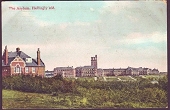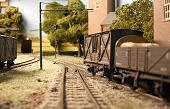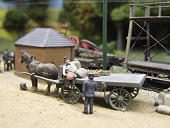

When the new asylum built for East Sussex County Council was completed in 1902, the Visiting committee took the revolutionary step of not only retaining the contractors railway used in the construction, but electrifying it, creating one of the most unusual railway lines in the country. Intended to bring coal to the hospital generating stations it also had a limited passenger service ferrying inmates and visitors from nearby Hellingly station. Throughout it’s life the line had one
locomotive and a tramcar, although the later fell in disuse when the passenger service ended in 1931. The line itself lasted until March 10th 1959.

I built the model because of the delightful drawing on the front of the book called “The Hellingly Hospital Railway” by Peter A Harding which aroused my interest in unusual railways. I also wished to build a model that could be transported on the back seat of my VW Beetle so the scenic section was limited to four feet long.
The model is set during the end of the construction of the line. The contractors, with their own locomotive, are finishing their work and the electric locomotive and tramcar are running.

Although much “modellers licence” has been used, I hope the model gives you as much pleasure to see as I have had building it.I built the model because of the delightful drawing on the front of the book called “The Hellingly Hospital Railway” by Peter A Harding which aroused my interest in unusual railways. I also wished to build a model that could be transported on the back seat of my VW Beetle so the scenic section was limited to four feet long. The model is set during the end of the construction of the line. The contractors, with their own locomotive, are finishing their work and the electric locomotive and tramcar are running.
All track work is scratch built using SMP rail on copper-clad sleepers with point operation provided by a manual system based on parts used by aeromodellers. Buildings are Daler board covered with embossed plasticard, they are based on photographs of the prototype, especially the engine shed which appears in many of the pictures taken by those on railtours who explored the line in its final days.
Although much “modellers licence” has been used, I hope the model gives you as much pleasure to see as I have had building it.I built the model because of the delightful drawing on the front of the book called “The Hellingly Hospital Railway” by Peter A Harding which aroused my interest in unusual railways. I also wished to build a model that could be transported on the back seat of my VW Beetle so the scenic section was limited to four feet long. The model is set during the end of the construction of the line. The contractors, with their own locomotive, are finishing their work and the electric locomotive and tramcar are running.
All track work is scratch built using SMP rail on copper-clad sleepers with point operation provided by a manual system based on parts used by aeromodellers. Buildings are Daler board covered with embossed plasticard, they are based on photographs of the prototype, especially the engine shed which appears in many of the pictures taken by those on railtours who explored the line in its final days.
Although much “modellers licence” has been used, I hope the model gives you as much pleasure to see as I have had building it.I built the model because of the delightful drawing on the front of the book called “The Hellingly Hospital Railway” by Peter A Harding which aroused my interest in unusual railways. I also wished to build a model that could be transported on the back seat of my VW Beetle so the scenic section was limited to four feet long. The model is set during the end of the construction of the line. The contractors, with their own locomotive, are finishing their work and the electric locomotive and tramcar are running.
All track work is scratch built using SMP rail on copper-clad sleepers with point operation provided by a manual system based on parts used by aeromodellers. Buildings are Daler board covered with embossed plasticard, they are based on photographs of the prototype, especially the engine shed which appears in many of the pictures taken by those on railtours who explored the line in its final days.
Although much “modellers licence” has been used, I hope the model gives you as much pleasure to see as I have had building it.
If you have any questions or stories about the line, get in touch by e-mail at phil@pagenumberone.co.uk or read my blog for my latest modelling projects.